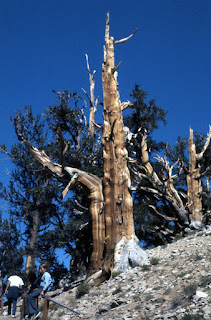The question is not quite as simple as it seems. I could make the argument that no bristlecone pine tree, or any tree, is more than 10 years old. The fact of the matter is that most of the 4000 rings in the tree are dead. The living tissues of the bristlecone pine consist only of a thin living bark, the root tips, the leaves, and twig tips of the most recent growth. No cell, tissue, or leaf is more than a few years old. So, yes, a bristlecone pine tree has been sitting at this spot for more than 4000 years, and the current growth is the result of the continuous activity of meristems that originated in a single seedling that germinated long ago, but none of the living parts are very old. The tissues of the tree constitute a genetic clone living on the edge of an accumulation of dead wood.
A tree is comparable in some ways to a coral colony. The individual coral polyps live a short time, but build a small "house" for themselves on top of previous generations of houses. The accumulation over many years results in a coral reef. Black coral colonies have a distinct tree-like structure, and their age can be determined by techniques similar to counting tree rings (http://www.usgs.gov/newsroom/article.asp?ID=2745). Some have been found to be about the same age as the oldest bristlecone pines. The individual coral animals, or polyps, reproduce asexually, increasing the number if individuals and the number of branches, and all trace back to the original polyp that started the colony, so like the tree, there is a genetic continuity of the clone that is quite old, though no individual polyp is very old. Clonal organisms, even those that leave remains like wood or a coral skeleton, represent longevity of genotypes, not of a functioning set of organs and tissues.
A fairly well-documented article in Wikipedia, a "List of long-living organisms," explores different ways in which organisms can get old. A number of other clonal plants and animals are mentioned. Some clonal plants are estimated to be tens of thousands of years old, not because they leave layers of wood, but because they spread slowly outward, sprouting new roots and abandoning the original center of the colony to decay. They form circular colonies similar to a fairy ring of mushrooms (fungal colonies likewise are potentially quite old). A colony of quaking aspen (Populus tremuloides) - trees that propagate asexually from their root system, have an age estimated by some at over 80,000 years, but could be much older.
Sea grass colonies have been estimated to be 200,000 years old, and it is theoretically possible that some ancient fern rhizomes have been creeping around for millions of years, leaving no traces of earlier rhizome segments by which to document their age. In short, clonal plants are potentially immortal. But does that really count? What is an "individual living organism?" Do we define it genetically, or in terms of how long tissues and organs keep going?
If we're talking about an integrated set of organs and tissues in a discrete individual, than a 120-year old human being is more impressive than any plant. Some of our tissues turn over during our lifetime, but some do not. I'm amazed that my own brain is still working at all! Some kinds of tortoises can live more than 170 years, and koi fish have been reported to be over 200 years old. Invertebrates like sea urchins and bivalve molluscs have been recorded at more than 200 years as well. (Sponges may live for 10,000 years or more, but are technically more like clonal colonies than individual animals.) Animals are different from plants, beginning small, but complete, and getting bigger with age. We have only one set of legs, eyes, etc., that have to last a lifetime. So we are really older than any tree or clonal organism.
So you can make an argument for many different "oldest" organisms, depending on how you set the rules.
A fairly well-documented article in Wikipedia, a "List of long-living organisms," explores different ways in which organisms can get old. A number of other clonal plants and animals are mentioned. Some clonal plants are estimated to be tens of thousands of years old, not because they leave layers of wood, but because they spread slowly outward, sprouting new roots and abandoning the original center of the colony to decay. They form circular colonies similar to a fairy ring of mushrooms (fungal colonies likewise are potentially quite old). A colony of quaking aspen (Populus tremuloides) - trees that propagate asexually from their root system, have an age estimated by some at over 80,000 years, but could be much older.
 |
| Clonal plants that spread by horizontal rhizomes, like this giant Gunnera, may potentially be the oldest living "individuals," but their age cannot really be measured. |
If we're talking about an integrated set of organs and tissues in a discrete individual, than a 120-year old human being is more impressive than any plant. Some of our tissues turn over during our lifetime, but some do not. I'm amazed that my own brain is still working at all! Some kinds of tortoises can live more than 170 years, and koi fish have been reported to be over 200 years old. Invertebrates like sea urchins and bivalve molluscs have been recorded at more than 200 years as well. (Sponges may live for 10,000 years or more, but are technically more like clonal colonies than individual animals.) Animals are different from plants, beginning small, but complete, and getting bigger with age. We have only one set of legs, eyes, etc., that have to last a lifetime. So we are really older than any tree or clonal organism.
So you can make an argument for many different "oldest" organisms, depending on how you set the rules.


Tidak ada komentar:
Posting Komentar